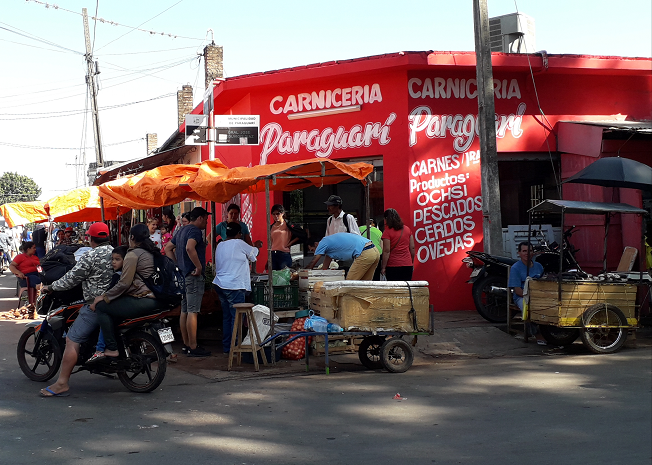There is one thing every town in Paraguay has in common with every other. That is its market.
From the smallest country town to the largest of the cities there is always a market to be found.
These do vary in size from place to place. In some towns they are large bustling places covering a large part of the city center. In others their prime days have long passed and they have shrunk back to being no more than a few roadside stalls.
Nowhere though have they been entirely driven out of business by newer arrivals such as the supermarkets. In fact in many towns they are thriving as prosperously as ever.
In the days before the advent of the all in one supermarkets the market was the center of a towns trade. Even now the goods on offer in a market far exceed those to be found in all but the very largest supermarkets. And the prices remain the lowest to be found in town.
A market in a Paraguayan town is a purpose built thing. The greater part is covered over as protection against the weather. Both the heat and the rain, through which trade must continue.
The tightly packed stalls under a low roof give a market the feel of a shopping center built in a labyrinth. Once within the entrance becomes obscured, revealed once more only though trial and error.
The stalls crowd in upon one another creating twisting pathways and endless small passageways.
One the whole the stalls within the market are grouped together. Like with like. Hence when one pile of shoes is spotted a shopper will know there are plenty more nearby.
Often a market will occupy an entire town block. Approachable from four sides and located in a prominent position in or near the town center.
Generally the outer stalls facing onto the street will sell fresh produce. Fruit, vegetables or meat. A site on the exterior of the market facing the street allows their stock to be delivered straight off a cart or truck. Avoiding the need to drag heavy bags of food stuffs deep into the market.
Within the market itself the stalls sell lighter less perishable products. These items such as clothing and small electricals are more suitable to being carried into the interior of the market and stacking high in boxes and on stalls.
Similar vendors with similar produce group together. In one area they may nothing but shoes to be seen, in another just childrens clothes and then in yet another accessories for cell phones.
A larger market will probably have hidden away in its center an area for buying cooked street food. Behind a number of small counters chefs will be cooking a steady stream of hot street food for the shoppers.
At times there will just be a small brazier and the food must be eaten on the go. At others the stall will be a little larger and have room for a counter and a couple of stools. Either way the smell of food fills the air with a rich odor which draws in more hungry shoppers.
Others have within them a creche. Here stall holders can leave their children to be cared for allowing them free to attend to the days business.
One of the biggest markets in the country is unsurprisingly found in Asuncion. This goes by the name of Mercado 4 and spreading out like it does across several blocks and streets is more of a community than just a market.
Here mixed in with dozens of stalls selling everything imaginable are several shops that would not look out of place on any high street. Its size is daunting but once what’s sought is found the prices are some of the lowest in the land.
As well as selling individual items Mercado 4 does a lot of business in bulk. Many shops keepers from around the country flock here to purchase items that they may then sell in their shops. Clothing especially is bought and spread around the country in that way.
There are no markets as large as that in my local towns. However the two in Paraguari and Piribebuy show the two different ends of spectrum of scale.
Paraguari is traditionally a market town. Accordingly it is no surprise that the market there is large and thriving. The town of Paraguari as well as being the county town acts as the commercial hub for a large surrounding area.
The market sits on one side of the towns central plaza. Its front is home to the town bus terminal and so it is the transport as well as commercial center of the town.
The market occupies a complete city block. Within it can be found everything that would be expected in a Paraguayan market including a food hall and a creche. Even the presence within walking distance of two large supermarkets has not effected the hectic daily bustle within the market.
The other market in Piribebuy shows the other extreme.
It to is located as the towns bus terminal. This though is positioned several blocks from the town center and is little used. Even before the arrival in town of a supermarket the market had withered away. Now it is little more than a few roadside stalls selling fruit and vegetables.
A market though it still is and however little used a market it will remain.
And so will all the other markets in towns across Paraguay. As long as there are towns and as long as there are shoppers there will always be markets in Paraguay.


Recent Comments